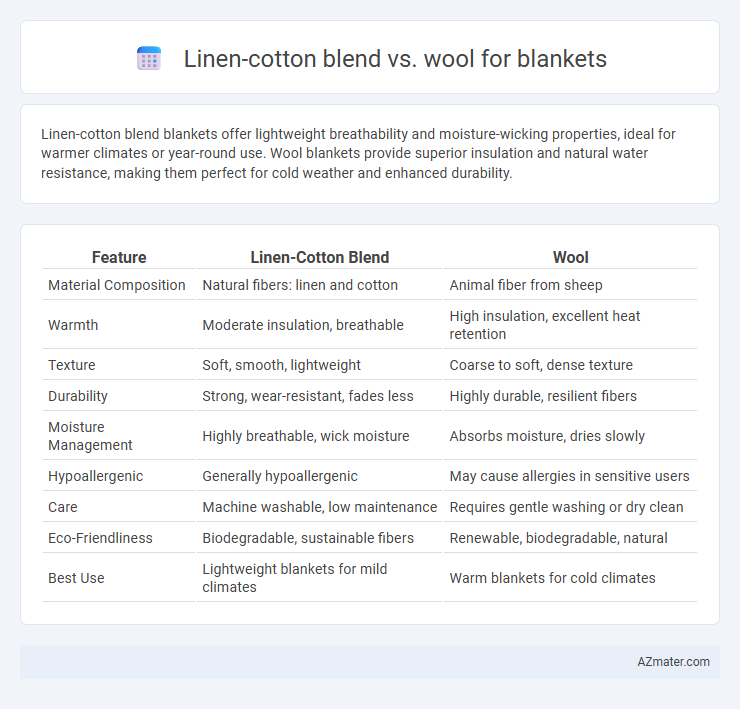Linen-cotton blend blankets offer lightweight breathability and moisture-wicking properties, ideal for warmer climates or year-round use. Wool blankets provide superior insulation and natural water resistance, making them perfect for cold weather and enhanced durability.
Table of Comparison
| Feature | Linen-Cotton Blend | Wool |
|---|---|---|
| Material Composition | Natural fibers: linen and cotton | Animal fiber from sheep |
| Warmth | Moderate insulation, breathable | High insulation, excellent heat retention |
| Texture | Soft, smooth, lightweight | Coarse to soft, dense texture |
| Durability | Strong, wear-resistant, fades less | Highly durable, resilient fibers |
| Moisture Management | Highly breathable, wick moisture | Absorbs moisture, dries slowly |
| Hypoallergenic | Generally hypoallergenic | May cause allergies in sensitive users |
| Care | Machine washable, low maintenance | Requires gentle washing or dry clean |
| Eco-Friendliness | Biodegradable, sustainable fibers | Renewable, biodegradable, natural |
| Best Use | Lightweight blankets for mild climates | Warm blankets for cold climates |
Introduction to Blanket Material Choices
Linen-cotton blend blankets offer a lightweight, breathable option ideal for warmer climates, combining the durability of linen with the softness of cotton. Wool blankets provide superior insulation and moisture-wicking properties, making them perfect for colder environments and winter use. Selecting between linen-cotton blend and wool depends on desired warmth, texture, and maintenance preferences.
Composition and Characteristics of Linen-Cotton Blend
Linen-cotton blend blankets combine the natural breathability and moisture-wicking properties of linen with the softness and durability of cotton, resulting in a lightweight, breathable fabric ideal for year-round use. This blend offers enhanced strength and wrinkle resistance compared to pure cotton, while maintaining a cool, smooth texture that also ages well over time. The fabric's hypoallergenic and eco-friendly nature makes it a preferred choice for sensitive skin and sustainable home textiles.
Wool: Properties and Unique Features
Wool blankets offer exceptional insulation due to their natural crimped fibers, providing superior warmth and moisture-wicking properties compared to linen-cotton blends. Their durability and resistance to wrinkles and odors make wool an ideal choice for long-lasting comfort and maintenance ease. Unique features such as flame-retardant qualities and hypoallergenic benefits further distinguish wool blankets in home textiles.
Warmth and Insulation Comparison
Linen-cotton blend blankets provide moderate warmth with breathable insulation, making them ideal for mild to cool climates due to their moisture-wicking properties and lightweight feel. Wool blankets offer superior warmth and insulation, as the natural crimp in wool fibers traps heat efficiently, maintaining body temperature even in damp conditions. For optimal thermal performance, wool blankets outperform linen-cotton blends by providing better heat retention and enhanced durability in colder environments.
Breathability and Moisture Management
Linen-cotton blend blankets excel in breathability and moisture management due to the natural fibers' ability to wick away moisture and promote air circulation, keeping sleepers cool and dry. Wool blankets, while also breathable, provide superior insulation by trapping air and moisture away from the skin, making them ideal for cooler environments. The linen-cotton blend is preferred for warm climates or those who sweat at night, whereas wool offers enhanced temperature regulation and moisture control in colder conditions.
Durability and Longevity
Linen-cotton blend blankets offer excellent durability due to the strong fibers of linen combined with the softness of cotton, ensuring long-lasting use without significant wear or pilling. Wool blankets excel in longevity thanks to their natural resilience and ability to retain shape and warmth over many years, resisting abrasions and moisture damage. Both fabrics provide robust options, with linen-cotton blends favored for lightweight breathability and wool preferred for enduring warmth and sturdiness.
Comfort and Texture
A linen-cotton blend blanket offers a lightweight, breathable texture ideal for warm climates, providing a soft yet durable comfort that becomes cozier with use. Wool blankets present a naturally insulating, lofty texture that delivers superior warmth and moisture-wicking properties, making them perfect for colder environments. Both fabrics enhance comfort through distinct tactile qualities, with linen-cotton excelling in cool softness and wool focusing on thermal regulation and plushness.
Maintenance and Care Requirements
Linen-cotton blend blankets require minimal maintenance, needing gentle machine wash with mild detergent and air drying to prevent shrinkage and maintain fabric softness. Wool blankets demand careful care, including hand washing or dry cleaning, avoiding high temperatures to prevent felting and shrinkage. Both materials benefit from regular airing to keep freshness, but wool's natural lanolin content offers inherent resistance to odors and stains, reducing the frequency of washing compared to linen-cotton blends.
Eco-Friendliness and Sustainability
Linen-cotton blend blankets offer superior eco-friendliness due to the renewable nature of flax and cotton fibers, their biodegradability, and lower water and pesticide usage during cultivation compared to wool. Wool production entails higher environmental costs, including methane emissions from sheep and significant land use, though wool is biodegradable and durable. Choosing linen-cotton blend blankets supports sustainability by minimizing carbon footprint and promoting renewable resource use in textile manufacturing.
Best Uses: Choosing the Right Blanket for Your Needs
Linen-cotton blend blankets excel in breathability and moisture-wicking, making them ideal for warm climates or those who tend to overheat at night. Wool blankets provide superior insulation and natural temperature regulation, suitable for cold weather and outdoor use. Selecting between these fabrics depends on your climate and personal comfort preferences, with linen-cotton favored for lighter warmth and wool for maximum coziness.

Infographic: Linen-cotton blend vs Wool for Blanket
 azmater.com
azmater.com